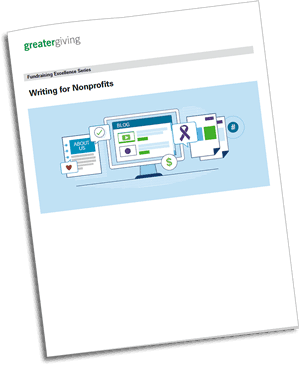

This post is the second in a series designed to teach the art and fundamentals of writing for nonprofits. These posts are based on the “Writing for Nonprofits” Guide from the Greater Giving Fundraising Excellence Series. Each new post focuses on an individual type of communication or relationship, and how best to tailor your writing to it. Read additional articles: Writing For Nonprofits Series
Last article we talked about Developing Your Organization’s Unique Voice and before we dive too far into the rest of this series—which will include specific strategies and techniques for capital campaigns, for writing for email, for engaging on social media, how to ask for donations, and more—I want to take a step back and talk about one group in particular that is invaluable to your organization: your major donors.
Communicating and writing for our major donors is a year-round, continuous effort, so I want you to get started on cultivating this relationship as soon as possible.
Last time, we talked about voice, and how to develop a consistent way of writing that represents the values and attitudes of your organization. And one of the things I discussed in that post was how to modify that voice for particular channels and particular audiences— such as your major donors.
 But writing for your major donors, from maintaining contact from year to year, to soliciting them for sponsorships, to sending out thank you letters, all require a special touch. You’ll need to know your donor inside and out, and understand their needs, dreams, and passions if you’re going to maintain their support while simultaneously amping up their engagement.
But writing for your major donors, from maintaining contact from year to year, to soliciting them for sponsorships, to sending out thank you letters, all require a special touch. You’ll need to know your donor inside and out, and understand their needs, dreams, and passions if you’re going to maintain their support while simultaneously amping up their engagement.Engage Donors with a Personal Touch
Everybody wants to feel special. The more we engage with donors and supporters on a personal level, the more special they feel—and the more likely they are to keep coming back, and keep donating money. But how do you get across that you care, that they matter to you regardless of money?
 Start by developing an information database about your donors of what they care about personally, their passions, and things they’ve told you in the past that they need to support their business’s progress. Keep these things in mind whenever you talk to or write to your donors. This personal touch is what your donors that you care about them.
Start by developing an information database about your donors of what they care about personally, their passions, and things they’ve told you in the past that they need to support their business’s progress. Keep these things in mind whenever you talk to or write to your donors. This personal touch is what your donors that you care about them.
Here are some further ideas for making that outreach feel special and personal.
- For your big asks, such as sending out sponsor invitations to your annual gala, make sure you reach out to your major donors personally, rather than with a general solicitation email or snail mail invitation.
- Make your donor feel welcome, and more importantly, indispensible. Don’t be afraid of showing donors how critical their support is to your continued work. Demonstrate how their continued support has made your mission possible by linking a past donation to a specific project or victory your organization has achieved. Consider including a photo for a more personal touch.
And these ideas can help secure sponsorships at your next event.
TIP
Though this series focuses on writing for nonprofits, a lot of these tips and tricks transfer over to any kind of communication with your donor base—including the phone. Don’t discount the power of a phone call! In a lot of cases with major donors, a phone call is the best way to secure a commitment. It’s personal, , and you can communicate with your donor in real time about what their needs are and how you can help solve them.
- Make it all about them. Tell your donor about the special table you’ve already picked out for them at your event. List their friends who are also attending. Show them you know all about their preferences; demonstrate how they’re a VIP on your list and what you’ll do to accommodate them.
- Assure your donor that supporting your organization and attending your event won’t be a chore; focus instead on ways you’ve customized their experience to be a pleasure and a delight! You know what your donor likes and enjoys—tailor your message to that. Advertise what a great time they’ll have sponsoring and participating in your event.
Show Your Donors How Much You Care
So let’s talk about some specific language you can use to drive your message home—the message that you care about your donors, and that their involvement means the world to you and to your mission.
- Always talk to your donor; avoid statements that imply a broad or generalized audience.
- Focus on what the donor might want or need, rather than what you and your nonprofit want or need. Frame your ask in terms of what benefits your nonprofit can provide the donor, not the other way around.
- Write to your donor’s passions. Streamline your communications around what you know interests your donor about your organization and play to those.
- Always make the donor feel active and valued in the transaction. Does a major donor at your animal shelter especially love dogs? Try: “You’ll be instrumental in keeping an additional 100 dogs in no-kill shelters.”
- Avoid talking about gifts in terms of what they can do for your organization (or what you need in terms of money). Instead, discuss major gifts in terms of results.
- Frame every ask, which should probably be done over the phone, as part of achieving an objective. E.g., “This donation will directly fund this project, mission, or beneficiary.”
 And Keep Donors Forever!
And Keep Donors Forever!
The last, but most important, strategy is to keep in touch with donors even when you don’t need anything from them.
Send regular updates about the great work their money is doing. Ask them about themselves—their interests, passions, and goals. Remember what makes your donor tick and ask them how they’ve progressed toward achieving their own goals. Treat your donor like a valued friend and member of the community, rather than as a piggy bank. Send thoughtful, personalized holiday cards, birthday cards, and always respond when crisis strikes.
A donor that feels genuinely appreciated and valuable will come back year after year—and each time our donor leaves the interaction happy, we can ask for more next year!
Check in for our next article and learn how to: Turn a Mission Into a Shareable Story

